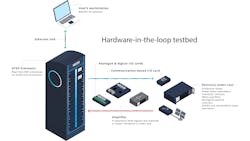As we navigate through 2025, the global power system landscape is marked by significant trends that are reshaping the industry. These trends are driven by technological advancements, geopolitics, regulatory changes, and the increasing demand for sustainable, efficient, and secure power solutions. Key areas of focus include inverter-based resources and renewable energy, data centers, electric vehicles, and hydrogen-based multi-energy systems.
Major power outages, such as the recent blackouts in the Iberian Peninsula and Chile in 2025, are drawing global attention to the need for reliable and resilient energy infrastructure. Causes for these failures vary significantly – protection system maloperation, unexpected tripping of renewable generation, severe weather, cybersecurity, and aging equipment can be at play – but one thing is clear: detailed studies and comprehensive testing methods are critical for anticipating and mitigating vulnerabilities on the modern grid. In today’s power system, where we have replaced much of our conventional generation with inverter-based resources, where larger-than-ever loads are making their debut around the world, and where we rely much more heavily on digital technologies and communication, we’re facing risks and vulnerabilities that we largely haven’t seen before.
The RTDS Simulator has been in use by leaders in the power system community for over 30 years. The hardware-in-the-loop (HIL) testing process that this technology enables provides unparalleled insight into the behaviour of power system control and protection devices prior to their deployment on the grid. Hardware-in-the-loop testing with a real-time power system simulator allows users to expose devices and schemes to a wide variety of power system conditions and observe their dynamic response in the safety of a laboratory environment. New power system technologies, settings, and configurations must be de-risked to ensure a resilient grid response in difficult conditions, preventing avoidable outages, and optimizing system operation for sustainable and economical performance.
To perform HIL testing, the user creates a detailed model of the power system using the RTDS Simulator’s software. The simulation runs on dedicated processing hardware capable of generating instantaneous power system data in real time. Real devices, such as control and protection hardware, are then connected to the simulated network in a closed loop via analogue, digital, or communication protocol-based signals, allowing for comprehensive testing in the simulated environment.
As the grid has modernized, so has the RTDS Simulator; the technology has evolved to include detailed representation of power electronic converters, Ethernet-based communication for automation, complex load profiles, and more. In 2025, transmission and distribution system operators, power system solution manufacturers, consultants, research institutions, and universities are applying this technology to emerging and critical application areas.
Inverter-based resources and other renewables are increasingly present in power systems worldwide, but their secure integration remains a challenge. Detailed, accurate modelling of renewable plants, their associated power electronic converters, and their controls (including inverter controls, battery management, power plant controls, microgrid controllers, and more) is essential for understanding how these resources will respond and interact with other assets during various grid conditions. Standards defining the required dynamic behaviour of inverter-based resources are needed. Simulation studies and testing tools allow for vendors, utilities and system operators, and consultants to prove that inverter-based resources perform as expected when it comes to fault ride-through, ancillary services, and other aspects of plant performance. Hardware-in-the-loop testing provides a platform for validating software models of devices and demonstrating how a resource will perform in a specific power system, increasing confidence from project stakeholders.
Software-in-the-loop (SIL) testing with the RTDS Simulator is also a key approach for de-risking inverter-based resources. SIL testing allows for the integration of vendor-specific controls into the real-time simulation environment without the physical hardware being present. The vendor cross-compiles their control code into a protected library file, which runs on dedicated system-on-a-chip hardware in parallel with the power system simulation. This powerful approach allows generic models to be replaced with vendor-specific controls, ensuring accurate representation of plant behaviour for utilities and other stakeholders. SIL and HIL testing can also be combined to de-risk the interoperation of multiple devices from different vendors in the same testbed.
The growth of AI and machine learning has resulted in a huge demand for data centers. These massive loads – with projects in the GW range planned – have complex profiles and high reliability requirements. As utilities endeavour to understand and accommodate these loads, project timelines and high power requirements mean that many data centers rely on behind-the-meter generation. Real-time simulation provides an efficient means for studying the data center’s power system with a very high level of detail. Hardware-in-the-loop testing of protection relays, UPS controls, and energy management systems can improve the reliability, cost, and speed of data center electrical architecture deployment. HIL testing provides insights into scheme vulnerabilities and identifies gaps in advance of field deployment, shifting risks to earlier stages of the project.
Beyond data centers, there are other large and complex loads on the power system road map for 2025. As hydrogen production increases, particularly in the decarbonization of industrial processes, studying electrolysers, storage, and other components of hydrogen-based multi-energy systems is essential. The RTDS Simulator enables detailed modelling of the electrical and thermohydraulic aspects of these plants, and HIL testing of plant controls. Utilities are also managing the increasing integration of vehicle charging stations – more large loads to securely accommodate while addressing power quality and stability concerns.
To learn more about how the RTDS Simulator is being used for de-risking the biggest power system concerns in 2025, head to our free webinar library at www.rtds.com/webinars.


